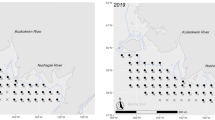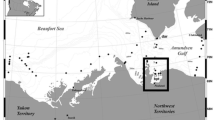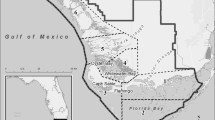Abstract
Spatial and temporal variability in fish tissue lipid content may reflect resource availability, reproductive or maturity state, or environmental suitability. Here, we analyzed nonpolar (storage) lipid and morphometric condition indices of black sea bass (Centropristis striata) collected from coastal waters of the Northwest Atlantic Ocean from New Jersey to North Carolina, USA. We hypothesized that the elemental ratio of carbon to nitrogen (C:N) within C. striata white muscle and liver tissue would be a robust proxy for nonpolar lipid content (NPLC) and that NPLC would predictably covary with traditional condition indices. Further, we analyzed our NPLC tissue indices to determine how regional and biological patterns in muscle and liver NPLC aligned with traditional condition indices. Our results indicated that muscle tissue NPLC was low compared to liver tissue, and regression analysis revealed strong positive relationships between C:N and NPLC for both tissues (muscle—best fit was linear; liver—best fit was asymptotic nonlinear). Correlations of muscle and liver NPLC with other condition indices were index and region dependent (e.g., a reproductive index was positively correlated with muscle NPLC, but negatively correlated with liver NPLC). Tissue NPLC and standard condition indices differed significantly as a function of region, sex, and fish length, although the patterns were not consistent across the different indices. Our results support the use of muscle and liver C:N values to estimate tissue-specific C. striata NPLC. Further, our results indicate that NPLC indices provide additional insight into C. striata physiological condition and could assist studies examining habitat suitability across large spatial or temporal scales.




Similar content being viewed by others
Data availability
The datasets during and/or analyzed during the current study are available from the corresponding author on reasonable request.
References
Akaike H (1974) A new look at the statistical model identification. IEEE Trans Autom Control 19(6):716–723
Alam MS, Watanabe WO, Carroll PM, Rezek T (2009) Effects of dietary protein and lipid levels on growth performance and body composition of black sea bass Centropristis striata (Linnaeus 1758) during grow-out in a pilot-scale marine recirculating system. Aquac Res 40:442–449. https://doi.org/10.1111/j.1365-2109.2008.02113.x
Amara R, Meziane T, Gilliers C, Hermel G, Laffargue P (2007) Growth and condition indices in juvenile sole Solea solea measured to assess the quality of essential fish habitat. Mar Ecol Prog Ser 351:201–208
Amara R, Selleslagh J, Billon G, Minier C (2009) Growth and condition of 0-group European flounder, Platichthys flesus as indicator of estuarine habitat quality. Hydrobiologia 627:87–98
Arnott SA, Chiba S, Conover DO (2006) Evolution of intrinsic growth rate: metabolic costs drive trade-offs between growth and swimming performance in Menidia menidia. Evolution 60:1269–1278
Bentley CD, Watanabe WO, Rezek TC, Seaton PJ (2009) Preliminary investigations on the effects of dietary lipid on the spawning performance and egg quality of black sea bass Centropristis striata L. Aquac Res 40:1873–1883. https://doi.org/10.1111/j.1365-2109.2009.02293.x
Billerbeck JM, Schultz ET, Conover DO (2000) Adaptive variation in energy acquisition and allocation among latitudinal populations of the Atlantic silverside. Oecologia 122:210–219
DeNiro MJ, Epstein S (1977) Mechanism of carbon isotope fractionation associated with lipid-synthesis. Science 197:261–263. https://doi.org/10.1126/science.327543
Conover DO, Present TMC (1990) Countergradient variation in growth rate: compensation for length of the growing season among Atlantic silversides from different latitudes. Oecologia 83:316–324
Cone RS (1989) The need to reconsider the use of condition indices in fishery science. Trans Am Fish Soc 118:510–514. https://doi.org/10.1577/1548-8659
Dadswell MJ, Taubert BD, Squiers TS, Marchette D, Buckley J (1984) Synopsis of biological data on shortnose sturgeon, Acipenser brevirostrum LeSueur 1818
Dawson AS, Grimm AS (1980) Quantitative seasonal changes in the protein, lipid and energy content of the carcass, ovaries and liver of adult female plaice, Pleuronectes platessa L. J Fish Biol 16:493–504
Diaz RJ, Solan M, Valente RM (2004) A review of approaches for classifying benthic habitats and evaluating habitat quality. J Environ Manag 73:165–181
Dobush GR, Ankney CD, Krementz DG (1985) The effect of apparatus, extraction time, and solvent type on lipid extractions of snow geese. Can J Zool 63:1917–1920. https://doi.org/10.1139/z85-285
Drohan AF, Manderson JP, Packer DB (2007) Essential fish habitat source document: black sea bass, Centropristis striata, life history and habitat characteristics. NOAA Technical Memorandum
Focken U, Becker K (1998) Metabolic fractionation of stable carbon isotopes: implications of different proximate compositions for studies of the aquatic food webs using delta C-13 data. Oecologia 115:337–343. https://doi.org/10.1007/s004420050525
Folch J, Lees M, Sloane Stanley G (1957) A simple method for the isolation and purification of total lipides from animal tissues. J Biol Chem 226:497–509
Head MA, Keller AA, Bradburn M (2014) Maturity and growth of sablefish, Anoplopoma fimbria, along the U.S. West Coast Fish Res 159:56–67. https://doi.org/10.1016/j.fishres.2014.05.007
Hoffman JC, Sierszen ME, Cotter AM (2015) Fish tissue lipid-C: N relationships for correcting C-13 values and estimating lipid content in aquatic food-web studies. Rapid Commun Mass Spectrom 29:2069–2077. https://doi.org/10.1002/rcm.7367
Honeycutt ME, McFarland VA, McCant DD (1995) Comparison of 3 lipid extraction methods for fish. Bull Environ Contam Toxicol 55:469–472
Hurvich CM, Tsai CL (1993) A corrected Akaike information criterion for vector autoregressive model selection. J Time Ser Anal 14(3):271–279
Jennings S, Kaiser MJ, Reynolds JD (2001) Marine fisheries ecology. Blackwell Science Ltd., Oxford
Kiljunen M, Grey J, Sinisalo T, Harrod C, Immonen H, Jones RI (2006) A revised model for lipid-normalizing δ13C values from aquatic organisms, with implications for isotope mixing models. J Appl Ecol 43:1213–1222
Klibansky N, Scharf FS (2015) Success and failure assessing gonad maturity in sequentially hermaphroditic fishes: comparisons between macroscopic and microscopic methods. J Fish Biol 87:930–957
Lambert Y, Dutil JD (1997) Can simple condition indices be used to monitor and quantify seasonal changes in the energy reserves of cod (Gadus morhua)? Can J Fish Aquat Sci 54:104–112. https://doi.org/10.1139/cjfas-54-S1-104
Lloret J, Gil de Sola L, Souplet A, Galzin R (2002) Effects of large-scale habitat variability on condition of demersal exploited fish in the north-western Mediterranean. ICES J Mar Sci 59:1215–1227
Lloret J, Planes S (2003) Condition, feeding and reproductive potential of white seabream Diplodus sargus as indicators of habitat quality and the effect of reserve protection in the northwestern Mediterranean. Mar Ecol Prog Ser 248:197–208
Malloy KD, Targett TE (1994) Effects of ration limitation and low temperature on growth, biochemical condition, and survival of juvenile summer flounder from two Atlantic Coast nurseries. Trans Am Fish Soc 123:182–193. https://doi.org/10.1577/1548-8659(1994)123
Manirakiza P, Covaci A, Schepens P (2001) Comparative study on total lipid determination using Soxhlet, Roese-Gottlieb, Bligh & Dyer, and modified Bligh & Dyer extraction methods. J Food Compos Anal 14:93–100. https://doi.org/10.1006/jfca.2000.0972
McCartney MA, Burton ML, Lima TG (2013) Mitochondrial DNA differentiation between populations of black sea bass (Centropristis striata) across Cape Hatteras, North Carolina (USA). J Biogeogr 40:1386–1398. https://doi.org/10.1111/jbi.12103
McConnaughey T (1978) Ecosystems naturally labeled with carbon-13: applications to the study of consumer food webs. College of Environmental Sciences
McConnaughey T, McRoy CP (1979) Food-web structure and the fractionation of carbon isotopes in the Bering Sea. Mar Biol 53:257–262. https://doi.org/10.1007/bf00952434
Mercer LP (1989) Species profile: life histories and environmental requirements of coastal fishes and invertebrates (south Atlantic): black sea bass. U.S. Fish Wildl. Serv. Biol, Rep
Miller AS, Shepherd GR, Fratantoni (2016) Offshore Habitat preference of overwintering Juvenile and Adult Black Sea Bass, Centropristis striata, and the relationship to year-class success. PLoS One: 1–19
Moser J, Shepherd GR (2009) Seasonal distribution and movement of Black Sea Bass (Centropristis striata) in the Northwest Atlantic as determined from a mark-recapture experiment. J Northw Atlantic Fish Sci 40:17–28
Nash RDM, Valencia AH, Geffen AJ (2006) The origin of Fulton's condition factor—setting the record straight. Fisheries 31:236–238
Nelder JA, Wedderburn RWM (1972) Generalized linear models. J R Stat Soc Ser A (General) 135:370–384
Nelson J, Chanton J, Coleman F, Koenig C (2011) Patterns of stable carbon isotope turnover in gag, Mycteroperca microlepis, an economically important marine piscivore determined with a nonlethal surgical biopsy procedure. Environ Biol Fishes 90:243–252. https://doi.org/10.1007/s10641-010-9736-4
Piazza BP, La Peyre MK (2010) Using Gambusia affinis growth and condition to assess estuarine habitat quality: a comparison of indices. Mar Ecol Prog Ser 412:231–245
Pinnegar JK, Polunin NVC (1999) Differential fractionation of δ13C and δ15N among fish tissues: implications for the study of trophic interactions. Funct Ecol 13:225–231
Post DM, Layman CA, Arrington DA, Takimoto G, Quattrochi J, Montaña CG (2007) Getting to the fat of the matter: models, methods and assumptions for dealing with lipids in stable isotope analyses. Oecologia 152:179–189
R Core Team (2018) R: A language and environment for statistical computing. R Foundation for Statistical Computing, Vienna, Austria, pp https://www.R-project.org/
Roy EM, Quattro JM, Greig TW (2012) Genetic management of Black Sea Bass: influence of biogeographic barriers on population structure. Ma Coast Fishe 4:391–402. https://doi.org/10.1080/19425120.2012.675983
Rätz H-J, Lloret J, Casey J, Aglen A, Schopka SA, O'Brien L, Steingrund P (2000) Variation in fish condition between Atlantic cod (Gadus morhua) stocks and implications for their management. Fisheries Resource Managment: ICES CM 2000/V:2007
Schloesser RW, Fabrizio MC (2017) Condition indices as surrogates of energy density and lipid content in juveniles of three fish species. Trans Am Fish Soc 146:1058–1069
Schloesser RW, Fabrizio MC (2019) Nursery habitat quality assessed by the condition of juvenile fishes: not all estuarine areas are equal. Estuaries Coasts 42:548–566
Schultz ET, Conover DO (1997) Latitudinal differences in somatic energy storage: adaptive responses to seasonality in an estuarine fish (Atherinidae: Menidia menidia). Oecologia 109:516–529
Skinner MM, Martin AA, Moore BC (2016) Is lipid correction necessary in the stable isotope analysis of fish tissues? Rapid Commun Mass Spectrom 30:881–889. https://doi.org/10.1002/rcm.7480
Steimle FW, Zetlin CA, Berrien PL, Chang S (1999) Essential fish habitat source document: Black sea bss, Centropristis striata, life history and habitat characteristics. NOAA Technical Memorandum NMFS-NE-143, National Marine Fisheries Service, Northeast Fisheries Science Center.
Sweeting CJ, Polunin NVC, Jennings S (2006) Effects of chemical lipid extraction and arithmetic lipid correction on stable isotope ratios of fish tissues. Rapid Commun Mass Spectrom 20:595–601. https://doi.org/10.1002/rcm.2347
Tocher DR (2003) Metabolism and functions of lipids and fatty acids in teleost fish. Rev Fish Sci 11:107–184. https://doi.org/10.1080/713610925
Wuenschel MJ, Jugovich AR, Hare JA (2006) Estimating the energy density of fish: the importance of ontogeny. Trans Am Fish Soc 135:379–385. https://doi.org/10.1577/t04-233.1
Wuenschel MJ, McBride RS, Fitzhugh GR (2013) Relations between total gonad energy and physiological measures of condition in the period leading up to spawning: results of a laboratory experiment on black sea bass (Centropristis striata). Fish Res 138:110–119. https://doi.org/10.1016/j.fishres.2012.05.012
Wuenschel MJ, Shepherd GR, McBride RS, Jorgensen R, Oliveira K, Robillard E, Dayton J (2011) Sex and maturity of black sea bass collected in Massachusetts and Rhode Island waters; preliminary results based on macroscopic staging of gonads with a comparison to survey data. National Oceanic and Atmospheric Administration, Woods Hole
Wuenschel MJ, McElroy WD, Oliveira K, McBride RS (2019) Measuring fish condition: an evaluation of new and old metrics for three species with contrasting life histories. Can J Fish Aquat Sci 76(6):886–903
Yeung C, Yang M-S (2017) Habitat quality of the coastal southeastern Bering Sea for juvenile flatfishes from the relationships between diet, body condition and prey availability. J Sea Res 119:17–27
Zudaire I, Murua H, Grande M, Pernet F, Bodin N (2014) Accumulation and mobilization of lipids in relation to reproduction of yellowfin tuna (Thunnus albacares) in the Western Indian Ocean. Fish Res 160:50–59. https://doi.org/10.1016/j.fishres.2013.12.010
Acknowledgements
We thank Mark Wuenschel and an anonymous reviewer for reviewing previous versions of this manuscript. The authors wish to thank J. Molina, D. Quill and T. Van Gorden for their assistance with sample processing and data collection. T. Miller and R. Brodnik provided additional field and sample data as part of a NOAA project (NA15NMF4270289, award to T. Miller, O. Jensen, and J. Fodrie). We thank O. Jensen, J. Fodrie and others from Rutgers University and UNC Chapel Hill for coordinating field sampling events and assisting with sampling. C. Magen provided guidance and expertise with stable isotope and elemental analysis techniques. We are grateful to L. Cooper and B. Stevens for providing feedback on a previous version of this manuscript. The Chesapeake Biological Laboratory Graduate Education Committee provided financial support to GALR. This is UMCES Contribution number 5842.
Author information
Authors and Affiliations
Corresponding author
Ethics declarations
Conflict of interest
The authors declare that there are no conflicts of interest. GALR was funded through a Chesapeake Biological Laboratory Graduate Education Committee fellowship. All applicable international, national, and/or institutional guidelines for the sampling and experimental use of animals were followed and all necessary approvals have been obtained (i.e., University of Maryland Center for Environmental Science Institutional Animal Care and Use Committee approval).
Additional information
Responsible Editor: S. Hamilton.
Publisher's Note
Springer Nature remains neutral with regard to jurisdictional claims in published maps and institutional affiliations.
Reviewed by M. J. Wuenschel and an undisclosed expert.
Rights and permissions
About this article
Cite this article
La Rosa, G.A., Woodland, R.J. & Rowe, C.L. Carbon:nitrogen ratio as a proxy for tissue nonpolar lipid content and condition in black sea bass Centropristis striata along the Middle Atlantic Bight. Mar Biol 167, 77 (2020). https://doi.org/10.1007/s00227-020-03688-9
Received:
Accepted:
Published:
DOI: https://doi.org/10.1007/s00227-020-03688-9




